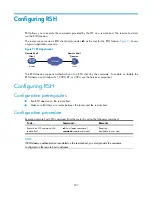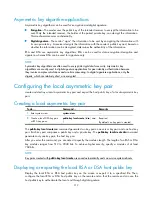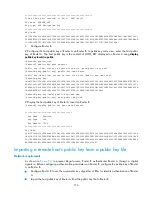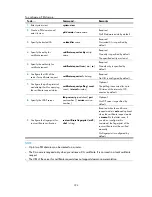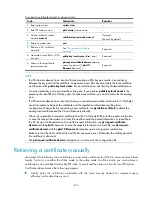
213
To display or export the local RSA or DSA host public key:
To do…
Command…
Remarks
1.
Enter system view.
system-view
—
2.
Display the local RSA host
public key on the screen in a
specified format, or export it
to a specified file.
public-key local export rsa
{
openssh
|
ssh1
|
ssh2
} [
filename
]
Select a command according to
the type of the key to be
exported.
3.
Display the local DSA host
public key on the screen in a
specified format, or export it
to a specified file.
public-key local export dsa
{
openssh
|
ssh2
} [
filename
]
Destroying an asymmetric key pair
You may have to destroy an asymmetric key pair and generate a new pair when an intrusion event has
occurred, the storage media of the device is replaced, the asymmetric key has been used for a long
time, or the certificate from the CA expires. To check the certificate status, use
display pki certificate
. For
more information, see "
."
To destroy an asymmetric key pair:
To do…
Command…
Remarks
Enter system view
system-view
—
Destroy an asymmetric key pair
public-key local destroy
{
dsa
|
rsa
}
Required
Configuring a remote host's public key
To enable your local host to authenticate a remote host, configure the remote host's RSA or DSA public
key on the local host. The following methods are available:
•
Import it from a public key file
—Obtain a copy of the remote host's public key file through FTP or
TFTP (in binary mode) first, and then import the public key from the file. During the import process,
the system automatically converts the public key to a string in PKCS format. HP recommends that
you follow this method to configure the remote host's public key.
•
Configure it manually
—If the remote host is an HP device, use
display public-key local public
to
view and record its public key. On the local host, enter or copy the key data in public key code
view. A public key displayed by other methods may not be in the PKCS format, and the system
cannot save the format-incompliant key.
NOTE:
The device supports up to 20 pubic keys of remote hosts.
To import a remote host's host public key from the public key file:
To do…
Command…
Remarks
1.
Enter system view.
system-view
—









